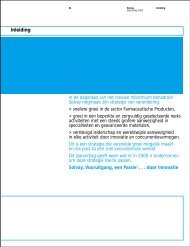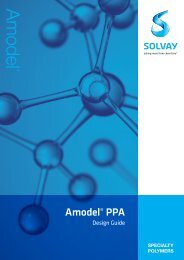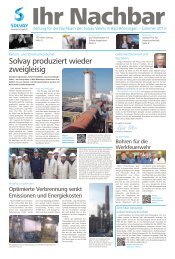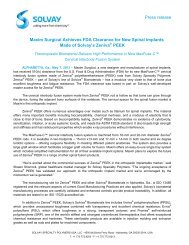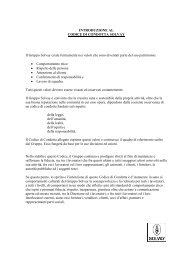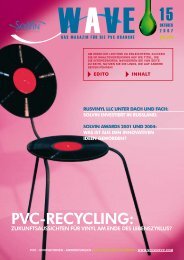Proprietà di creep nel lungo periodo - Solvay Plastics
Proprietà di creep nel lungo periodo - Solvay Plastics
Proprietà di creep nel lungo periodo - Solvay Plastics
You also want an ePaper? Increase the reach of your titles
YUMPU automatically turns print PDFs into web optimized ePapers that Google loves.
3<br />
Volume specifico<br />
I dati PVT (pressione, volume, temperatura) sono i valori delle<br />
equazioni <strong>di</strong> stato delle proprietà termo<strong>di</strong>namiche, che descrivono<br />
il coefficiente <strong>di</strong> <strong>di</strong>latazione volumetrica e <strong>di</strong> compressibilità <strong>di</strong> un<br />
materiale. Queste proprietà vengono generalmente utilizzate<br />
<strong>nel</strong>l’analisi <strong>di</strong> riempimento dello stampo me<strong>di</strong>ante algoritmi che<br />
fanno uso <strong>di</strong> equazioni per flui<strong>di</strong> comprimibili.<br />
La <strong>di</strong>latometria è il metodo preferito per misurare la variazione in<br />
volume <strong>di</strong> un provino soggetto a <strong>di</strong>verse temperature e pressioni.<br />
L’apparecchiatura per la <strong>di</strong>latometria ad alta pressione confina un<br />
campione del materiale stampato in un fluido del quale sia<br />
possibile variare la pressione. Viene utilizzato un aerometro per<br />
determinare la variazione reale in volume del campione al variare<br />
della temperatura e della pressione.<br />
I dati del volume specifico per il polisulfone UDEL sono riportati in<br />
tabella 10 e in figura 34.<br />
Figura 34<br />
Volume specifico del polisulfone UDEL in funzione della<br />
temperatura e della pressione<br />
0,90<br />
Temperatura, °F<br />
375 400 425 450 475 500 525 550 575 600<br />
Tabella 10<br />
Volume specifico (cm 3 /g) <strong>di</strong> PSU in funzione della<br />
temperatura e della pressione in fase liquida<br />
Pressione Temperatura, °C<br />
MPa 188,8 199,1 217,4 238,0 259,1 279,8 300,1<br />
0 0,8351 0,8413 0,8496 0,8601 0,8710 0,8811 0,8915<br />
10 0,8314 0,8361 0,8440 0,8540 0.8638 0,8737 0,8827<br />
20 0,8300 0,8382 0,8474 0,8563 0,8654 0,8735<br />
30 0,8256 0,8336 0,8428 0,8515 0,8602 0,8672<br />
40 0,8295 0,8382 0,8443 0,8550 0,8610<br />
50 0,8254 0,8340 0,8417 0,8499 0,8554<br />
60 0,8218 0,8301 0,8384 0,8453 0,8499<br />
70 0,8263 0,8347 0,8407 0,8453<br />
80 0,8226 0,8299 0,8362 0,8407<br />
90 0,8192 0,8259 0,8321 0,8362<br />
100 0,8159 0,8217 0,8282 0,8321<br />
110 0,8182 0,8245 0,8281<br />
120 0,8149 0,8209 0,8244<br />
130 0,8116 0,8171 0,8207<br />
140 0,8085 0,8138 0,8172<br />
150 0,8027 0,8103 0,8139<br />
160 0,8073 0,8167<br />
170 0,8040 0,8076<br />
180 0,8010 0,8048<br />
190 0,8020<br />
200 0,7993<br />
0MPa<br />
0,88<br />
10 MPa<br />
20 MPa<br />
30 MPa<br />
Volume specifico, cm /g<br />
0,86<br />
0,84<br />
0,82<br />
40 MPa<br />
50 MPa<br />
60 MPa<br />
70 MPa<br />
80 MPa<br />
90 MPa<br />
100 MPa<br />
110 MPa<br />
120 MPa<br />
130 MPa<br />
140 MPa<br />
150 MPa<br />
160 MPa<br />
170 MPa<br />
180 MPa<br />
0,80<br />
180 200 220 240 260 280 300 320<br />
Temperatura, °C<br />
Guida alla progettazione del polisulfone UDEL ® – 27 – Proprietà termiche



